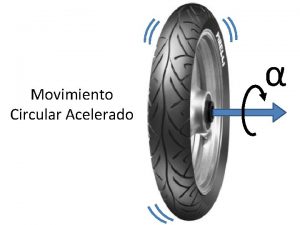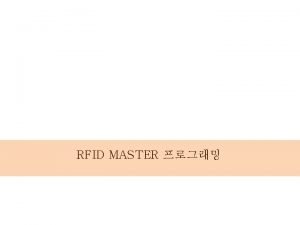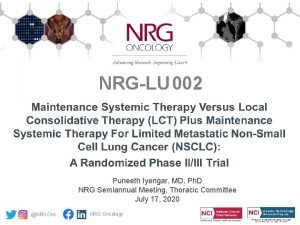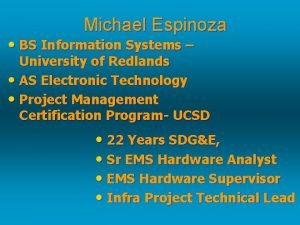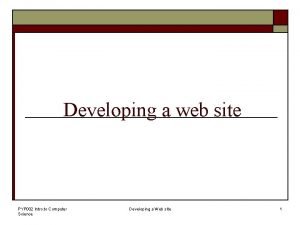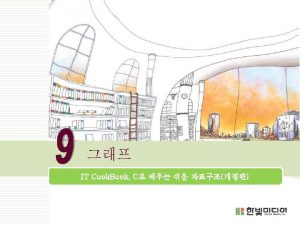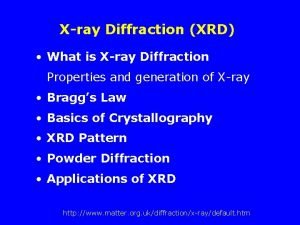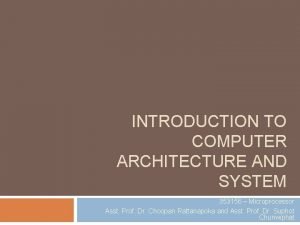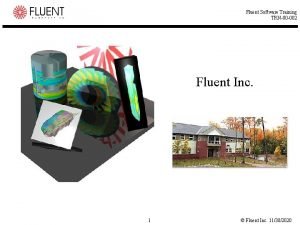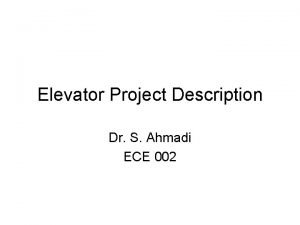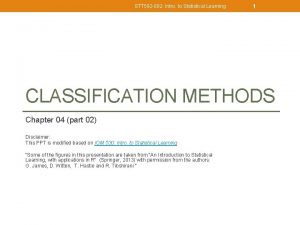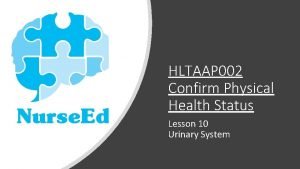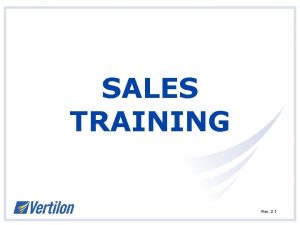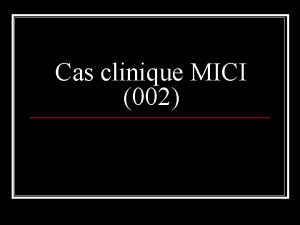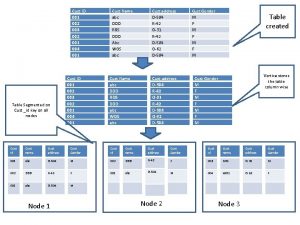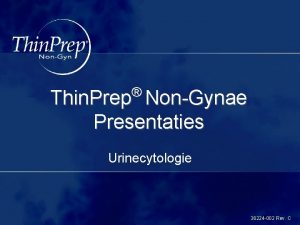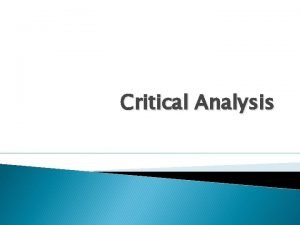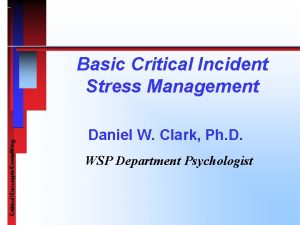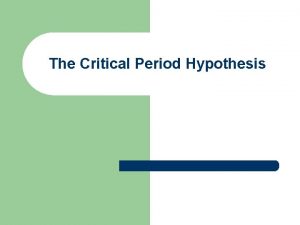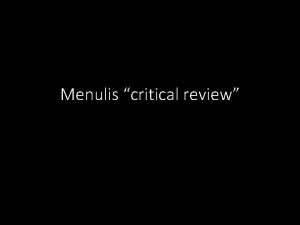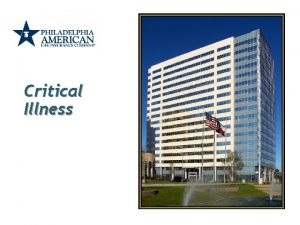Rev 002 Life Critical Requirements Training Overview What
























- Slides: 24

Rev 002 Life Critical Requirements

Training Overview • What are the Requirements? • Benefits of Compliance • Review Responsibilities – Management – Supervision – Personnel • Consequences of Non-Compliance – Applies to all Project Personnel – non-manual personnel, direct hire craft, manual workers, and subcontractors (all tiers) • Summary 2

What are Life Critical Requirements? • 12 requirements that if not complied with pose a significant risk to life and health • These are not new requirements – Based Royal Commission ES&H Manual (except Fitness for Work reminders) • Apply to all Contractor employees and subcontractor personnel who perform work on the project • Consistent consequences for non-compliance on every project 3

#1: Never work under the influence of drugs or alcohol. Always report to work fit for duty. Never use, possess, distribute, sell or be under the influence of illegal drugs and/or abuse controlled substances (including prescription drugs not authorized by a physician). Never consume or be under the influence of alcohol. Employees using prescription or legal non-prescription drug that might in any way impair their ability to perform assigned job duties shall immediately notify human resources/supervisor/Safety department before using the drug at work. Medications brought to site must have a prescription indicating employee name and quantity. 5

#2: Never work at height or near openings without required fall protection. Never expose yourself, direct/allow others to be exposed to potential falls from unprotected heights of 6 feet (1. 83 meters) or greater without the use of positive fall protection or fall arrest equipment. (Exception: Use of personal fall protection is not required when climbing or working on fixed ladders less than 24 feet (7. 3 meters) in length or on portable ladders). Always secure at an approved anchorage point. Never work around exposed edges and floor openings that are not securely covered and/or hard barricaded. Immediately report all unguarded edges and open holes. 5

#3: Never enter a confined space unless trained, authorized an entry permit has been completed. Never enter a confined space unless atmospheric testing has been performed. Never enter a confined space without an approved permit. Never enter a confined space without an attendant at the entrance and an effective way to communicate. 6

#4: Never commence work until all energy sources have been identified and isolated in accordance with procedures. Never remove and/or tamper with any tag and/or lock installed for the safety of personnel. Prior to work lock and tag machinery, equipment, components, and/or systems that may contain any type of stored energy. All residual/stored energy must be eliminated prior to any work activities. 7

#5: Never conduct lifting operations unless authorized and verified as competent. Never work under a suspended load. Operate all equipment in accordance with the manufacturer’s instructions/guidelines. Never walk or stand under a suspended load. Never hoist loads over people. Never work within a load shadow, i. e. , anywhere the load can fall. Never cross a barricade that controls an area with a suspended load unless you are authorized, i. e. , part of the lift team. Never operate cranes, lifting equipment, suspended personnel platforms, and/or rigging devices unless authorized and verified as competent. 8

#6: Never disable, bypass, modify or remove any safety protection device without authorization. This includes but is not limited to: Disconnecting load indicators Removing rotating equipment guards Fixing triggers/power switches in the “on” position Removing equipment/tool handles Hard wiring electrical wires into outlets Use of damaged equipment and/or tools Failure to inspect equipment and/or tools Failure to use equipment outrigger pads 9

#7: Never disregard or bypass signage and barricading. Only authorized personnel may work within “Danger” designated barricades indicated by red danger tape or international equivalent. Always isolate imminent danger areas with proper barricades and information tags. 10

#8: Never operate any mechanical elevated work platform without documented training. Never stand on the toe-board, mid-rail or top-rail of the basket. Never enter a basket without being tied off to the manufacturer’s designated anchor point, even during ground positioning, without documented approval for the deviation. Never exit the basket at height unless prior, documented, approval for the deviation has been obtained from Royal Commission ES&H personnel. 11

#9: Never access any scaffold without documented evidence of inspection by a designed Competent Person before each work shift. Obey the scaffold requirements at all times. Never use any scaffold without a current date tag (daily inspection). Scaffold rules include strict adherence to the color-coded tagging system of red, yellow and green tags as appropriate (some projects may not use yellow). Never access a red-tagged scaffold. Only authorized scaffold builders are permitted and they must wear required fall protection. Never access a yellow-tagged scaffold without 100% tie off or fall protection. Scaffolds not tagged are assumed to be redtagged. Never alter or modify a scaffold unless you are competent, qualified and authorized to do so. 12

# 10: Never access an excavation deeper than 4 feet (1. 2 meters) that has not been sloped, benched or shored an excavation permit completed. Never enter an excavation or trench, or direct others to enter without a prior, documented, formal assessment by a Competent Person. Never enter an excavation that does not have an up to date daily inspection checklist posted indicating that it is safe to enter. Never perform excavations without a Competent Person present. Adequate ingress/egress such as stairs and ladders are required within 25 feet (7. 6 meters) of each worker in all trenches greater than 4 feet (1. 2 meters) in depth. 13

# 11: Never work or walk around vehicles and machines that are not stopped , controlled or separated. Never operate equipment on site without identifying the swing radius, and barricading and signing accordingly. Never walk in a work area with mobile equipment operating without gaining approval and making positive contact with all drivers/operators. Only approach mobile equipment when it is stopped and secured from movement. Never walk near any moving mobile equipment on an access road that is not controlled by a banksman. Always use pedestrian access routes and dedicated crossing points, do not walk on roadways. NEVER go into a blind spot. 15

# 12: Never perform hazardous work without personal protective life saving equipment, training and authorization. Ensure respiratory protective equipment is available to all persons who are exposed to any situation in which there is a possibility of the atmosphere being or becoming deficient in oxygen or containing harmful substance (e. g. particle, dust, mist, vapor or gas). Never work without proper respiratory protective equipment selected on the basis of hazard in which you will be exposed and the information provided in Material Safety Data Sheet (MSDS) associated with the substance being used. 15

Benefits of Compliance • Common understanding of those risks that pose significant threat to life and health • Ensures understanding of how to work safely or if you don’t know – find out how • Addresses hazardous or at-risk behavior in a constructive and consistent manner • Encourages exercising our Stop Work Authority • Encourages reporting of all injuries / illnesses • Encourages Courageous Leadership 16

Responsibility – Contractor Site Management • Endorse Life Critical Requirements and answer employee questions prior to acknowledgement. • Facilitate training in the applicable ES&H Procedures and Job Site Work Rules to employees and subcontractors. • Implement Life Critical Requirements • Investigate and take appropriate action in response to identified non-compliance. 17

Responsibility – Site Supervision • Ensure training for employees in the applicable ES&H Procedures and Job Site Work Rules for the work they do. • Conduct pre work STARRT briefings. • Properly plan for tasks associated with Life Critical Requirements to mitigate the risk of potential hazards. • Report violations observed when employees perform work contrary to the established standards. Disciplinary action will be enforced if direction or failure of direction by supervisor results in a violation 18

Responsibility – Site Personnel All persons performing work on site are required to: • Read (or have read to you), understand acknowledge acceptance of the Life Critical Requirements • Participate in Life Critical Requirements training • Exercise your Stop Work Authority without fear of reprisal • Understand the task and perform it safely: if you don’t know how – ask! • Practice Courageous Leadership • Report injuries and illnesses immediately per project requirements 19

Understanding Non-Compliance - Compliance is a condition of employment and site access - Non-Compliance results in the actions defined by the guidelines - Non-Compliance by: - Contractor employees: Failure to comply will result in removal from Royal Commission jobsites. Rehire eligibility is at Royal Commissions sole discretion and will not be considered until a minimum of 6 months following termination. - Subcontractor employees: Failure to comply will result in removal from Royal Commission jobsites. Access will be reinstated at Royal Commissions sole discretion and will not be considered until a minimum of 6 months following denial of access. 20

Site Personnel Violation Consequences • Each identified rule violation will be investigated thoroughly • Two questions asked: 1. Was the individual informed of the rule? 2. Did the individual violate the rule? • If both answers are yes: • Appropriate action will be taken in accordance with the guidelines • If the answer is no: • The consequences under the guidelines will not apply • Each occurrence will be reviewed by Royal Commission Senior Management to ensure fairness of process and consistency. 21

Site Supervision Violation Consequences • Each rule violation will be thoroughly investigated • Question asked of the supervisor: 1. Did the direction or lack of direction by the supervisor result in the violation? • If the answer is yes: • Appropriate action will be taken in accordance with the guidelines • If the answer is no: • No action will be taken against the supervisor 22

Your Choice Safe At-risk If you choose to violate these requirements, you choose not to work at Royal Commission 23

In Summary The Requirements • • • Prevent loss of life or injury Provide clear & consistent set of requirements Create a culture of consistent compliance & consistent consequences for violations Requirements are not new – just calling attention to one’s that are life critical Compliance is mandatory – no exceptions 24
 Movimiento circular acelerado
Movimiento circular acelerado Critical semi critical and non critical instruments
Critical semi critical and non critical instruments Semi-critical
Semi-critical Mfc-002
Mfc-002 Norsok z-dp-002
Norsok z-dp-002 Semt.002
Semt.002 Puneeth iyengar
Puneeth iyengar Cip 002-009
Cip 002-009 Gmas-002
Gmas-002 Pyp 002
Pyp 002 001 002 003
001 002 003 Youtube
Youtube 002
002 002
002 Mu0 processor
Mu0 processor Pressão hidrostática
Pressão hidrostática 002
002 Elevator flowchart
Elevator flowchart Um objeto com massa de 10kg e volume de 0 002
Um objeto com massa de 10kg e volume de 0 002 002
002 Faculty marshall usc advertising csv
Faculty marshall usc advertising csv 002
002 Semt.002
Semt.002 Fibrous capsule
Fibrous capsule Um objeto com massa de 10kg e volume de 0 002
Um objeto com massa de 10kg e volume de 0 002
